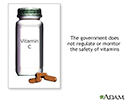Multiple vitamin overdose
Multiple vitamin overdose occurs when someone takes more than the normal or recommended amount of multivitamin supplements. This can be by accident or on purpose.
This is for information only and not for use in the treatment or management of an actual overdose. DO NOT use it to treat or manage an actual overdose. If you or someone you are with overdoses, call your local emergency number (such as 911), or your local poison center can be reached directly by calling the national toll-free Poison Help hotline (1-800-222-1222) from anywhere in the United States.
Poisonous Ingredient
Any ingredient in a multiple vitamin supplement can be toxic in large amounts, but the most serious risk comes from iron or calcium.
Iron
Iron is a mineral found in many over-the-counter supplements. Iron overdose occurs when someone takes more than the normal or recommended amount of ...
Where Found
Many multivitamin supplements are sold over-the-counter (without a prescription).
Symptoms
Below are symptoms of a multivitamin overdose in different parts of the body.
Overdose
An overdose is when you take more than the normal or recommended amount of something, usually a drug. An overdose may result in serious, harmful sym...
BLADDER AND KIDNEYS
- Cloudy urine
- Frequent urination
- Increased urine amount
EYES, EARS, NOSE, MOUTH, AND THROAT
- Dry, cracking lips (from chronic overdose)
- Eye irritation
- Increased sensitivity of the eyes to light
HEART AND BLOOD
- Irregular heartbeat
- Rapid heartbeat
MUSCLES AND JOINTS
-
Bone pain
Bone pain
Bone pain or tenderness is aching or other discomfort in one or more bones.
 ImageRead Article Now Book Mark Article
ImageRead Article Now Book Mark Article - Joint pain
- Muscle pain
- Muscle weakness
NERVOUS SYSTEM
- Confusion
- Convulsions (seizures)
- Fainting
- Fatigue
- Headache
- Mental changes
- Mood changes
- Irritability
SKIN AND HAIR
-
Flushing
(reddened skin) from niacin (vitamin B3)
Flushing
Skin blushing or flushing is a sudden reddening of the face, neck, or upper chest.
 ImageRead Article Now Book Mark Article
ImageRead Article Now Book Mark Article - Dry, cracking skin
-
Itching
, burning skin, or rash
Itching
Itching is a tingling or irritation of the skin that makes you want to scratch the area. Itching may occur all over the body or only in one location...
 ImageRead Article Now Book Mark Article
ImageRead Article Now Book Mark Article - Yellow-orange areas of skin
- Sensitive to sun (more likely to sunburn)
- Hair loss (from long-term overdose)
STOMACH AND INTESTINES
- Appetite loss
- Constipation (from iron or calcium)
- Diarrhea, possibly bloody
- Nausea and vomiting
- Stomach pain
- Weight loss (from long-term overdose)
Home Care
Seek medical help right away. Do NOT make a person throw up unless poison control or a health care professional tells you to.
Before Calling Emergency
Have this information ready:
- Person's age, weight, and condition
- The name of the product (ingredients and strengths, if known)
- Time it was swallowed
- The amount swallowed
Poison Control
Your local poison center can be reached directly by calling the national toll-free Poison Help hotline (1-800-222-1222) from anywhere in the United States. This national hotline number will let you talk to experts in poisoning. They will give you further instructions.
Local poison center
For a POISON EMERGENCY call:1-800-222-1222ANYWHERE IN THE UNITED STATESThis national hotline number will let you talk to experts in poisoning. This ...

This is a free and confidential service. All local poison control centers in the United States use this national number. You should call if you have any questions about poisoning or poison prevention. It does NOT need to be an emergency. You can call for any reason, 24 hours a day, 7 days a week.
What to Expect at the Emergency Room
Take the container with you to the hospital, if possible.
The health care provider will measure and monitor the person's vital signs, including temperature, pulse, breathing rate, and blood pressure. Symptoms will be treated. The person may receive:
- Activated charcoal
- Blood and urine tests
- Breathing support
- X-rays
- EKG (electrocardiogram, or heart tracing)
- Intravenous (IV) fluids through a vein
- Tube placed down the nose and into the stomach
- Medicines to treat symptoms
In severe cases, the person may be admitted to the hospital.
Outlook (Prognosis)
Niacin flush (vitamin B3) is uncomfortable, but lasts only 2 to 8 hours. Vitamins A and D may cause symptoms when large doses are taken each day, but a one large dose of these vitamins is rarely harmful. B vitamins usually do not cause symptoms.
If medical treatment is quickly received, people who have iron and calcium overdoses usually recover.
References
Muller AA, Henretig FM. The vitamins. In: Shannon MW, Borron SW, Burns MJ, eds. Haddad and Winchester's Clinical Management of Poisoning and Drug Overdose. 4th ed. Philadelphia, PA: Elsevier Saunders; 2007:chap 69.
Thomas SHL, White J. Poisoning. In: Walker BR, Colledge NR, Ralston SH, Penman ID, eds. Davidson's Principles and Practice of Medicine . 22nd ed. Elsevier; 2014:chap 9.
Velez LI, O'Connell EJ. Heavy metals. In: Marx JA, Hockberger RS, Walls RM, eds. Rosen's Emergency Medicine: Concepts and Clinical Practice . 8th ed. Philadelphia, PA: Elsevier Saunders; 2014:chap 157.
-
Vitamin safety - illustration
Although the government does not monitor the safety of vitamins, standard vitamin and mineral tablets are considered relatively risk-free if you avoid high doses.
Vitamin safety
illustration
-
Vitamins
(In-Depth)
Review Date: 7/11/2015
Reviewed By: Jacob L. Heller, MD, MHA, Emergency Medicine, Virginia Mason Medical Center, Seattle, WA. Also reviewed by David Zieve, MD, MHA, Isla Ogilvie, PhD, and the A.D.A.M. Editorial team.

